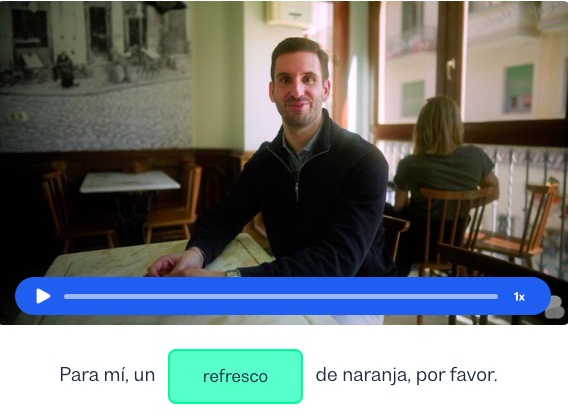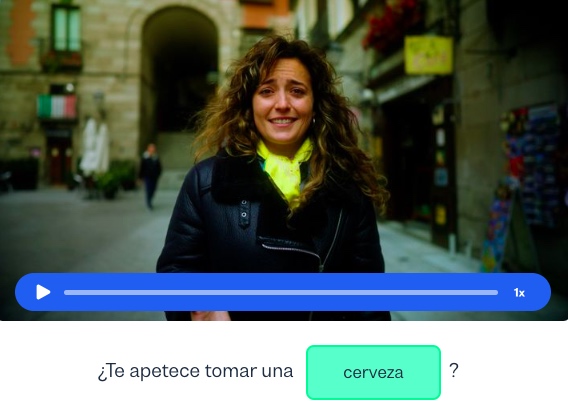Using Indefinite Articles in Spanish
Learn about Spanish indefinite articles and see how they are used
I want to learn...
Imagine you are strolling through a busy marketplace in Mexico. You are looking for a new backpack but don’t have anything specific in mind. You go to a stall owner and tell him what you are looking for: How can you say you need “a backpack” not “the backpack”?
In Spanish, these are called artículos indefinidos or artículos indeterminados (indefinite articles) and they are used to refer to non-specific or unidentified nouns. They are equivalent to the English articles "a" or "an."
The four Spanish indefinite articles
We use indefinite articles to introduce something for the first time or to talk about nonspecific things, places, or people.
Here, we’ll talk about the four indefinite articles: un, una, unos, and unas. These function similarly to the English indefinite articles “a,” “an,” and “some” but differ in that in Spanish, they must agree with the gender and number of the noun they modify.
Also, luckily, there are no major regional differences in indefinite article use between Spain and Latin America, which keeps things nice and simple for us.
Let’s take a closer look.
Indefinite articles in Spanish
| Gender/Number | Singular | Plural |
|---|---|---|
| Masculine | un | unos |
| Feminine | una | unas |
Here are some examples using these indefinite articles:
-
Veo un perro en el parque.
I see a dog in the park.
(singular, masculine noun) -
Estoy buscando una playa.
I’m looking for a beach.
(singular, feminine noun) -
Ellos tienen unos libros en el estante.
They have some books on the shelf.
(plural, masculine noun) -
Necesitamos unas sillas para el comedor.
We need some chairs for the dining room.
(plural, feminine noun)
Note: Did you notice how both the indefinite article and the noun end with an -s in the plural examples?
Consider the first example: Veo un perro en el parque. (I see a dog in the park). What if you saw multiple dogs? How would the noun and the indefinite article have to be changed?
- Veo unos perros en el parque.
I see some dogs in the park.
As you can see, we simply use the plural, masculine indefinite article unos and make sure that the noun matches by adding an -s.
In this sentence, the use of unos implies that there are dogs in the park but the exact number of dogs is not specified. You may hear Spanish speakers using algunos (some) sometimes as well. The meaning is basically the same, although algunos tends to imply a smaller, limited number.
Exceptions with Spanish indefinite articles
Things can’t be too simple, right? When it comes to indefinite articles in Spanish, it is important to familiarize yourself with some important exceptions.
1. Nouns starting with a stressed “a” sound
The noun agua (water) is a feminine noun in Spanish, but we use the indefinite article un (a) when referring to it because it begins with a stressed “a” sound.
This modification is simply because un agua is easier to say than una agua. The same goes for un alma (a soul), un águila (an eagle), and other words starting with a stressed “a” sound.
Keep in mind that this rule doesn’t apply to every feminine noun that begins with “a,” as it simply applies for nouns starting with a stressed “a” sound. Don’t worry, you’ll become familiar with stressed and unstressed vowels over time!
2. Dropping the indefinite article with occupations/professions
Unlike in English, we do not use the indefinite article in Spanish to indicate a profession. For example, Él es médico. (He is a doctor.)
3. Definite vs. indefinite articles in Spanish
How can you know when to use definite and indefinite articles in Spanish? Luckily, they follow similar rules to English.
Definite articles (el, la, los, las – “the”) are used to refer to something that was already mentioned, is known, or to indicate specificity.
Indefinite articles, as we discussed, are used to refer to nonspecific things, places, or people and to refer to something for the first time.
Let’s compare these two sentences:
-
Encontrarás el libro en la biblioteca.
You'll find the book in the library. -
Encontrarás un libro en la biblioteca.
You'll find a book in the library.
Maybe we are looking for a certain book. The first sentence tells us that we will find “the book” in the library, referring to that specific book. But if we are just interested in any book, the second sentence tells us that we will find “a book” in the library, meaning any, nonspecific book.
Spanish indefinite articles: Let’s wrap up
Spanish indefinite articles function much like indefinite articles in English and are used to indicate nonspecific things or to introduce something for the first time.
Unlike in English, however, the gender and the number of the noun must agree with the indefinite article.
There are some special uses to consider when learning your indefinite articles in Spanish, but as long as you practice your conversation skills, you’ll master them in no time.
Guess what? There’s more!
Don’t stop now. Continue practicing your indefinite articles with Busuu’s free online courses and grammar reviews and level up your Spanish speaking and writing skills.

